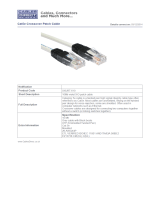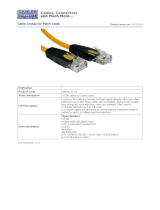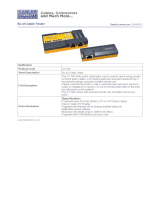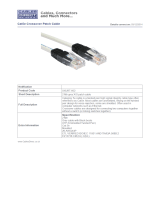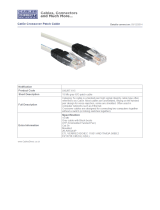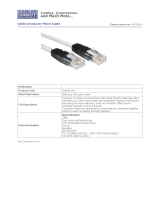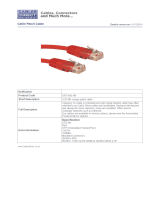Page is loading ...

TestifierPROf Test Set
User's Guide
www.jdsu.com/hbn
a
2007 JDSU.All rights reserved.


Power
Button
Setup
Up Button
Telco Mode Button
Coax Mode Button
LCD
Screen
Network
Mode Button
Down
Button
Select
Button
Remote
Data Jack
Telephone
Jack
Telephone
Jack
Data Jack
F-Connector
Jack (Coax)

Table of Contents
Features............................................... 1
Description .......................................... 3
Instructions for Use .......................... 17
Cable Testing ������������������������������� 17
To Map Cable ID’s ������������������������ 20
To Place Tone on a Cable ����������� 20
To Measure Length ���������������������� 21
To Perform Hub Blink ������������������ 23
Interpreting cable Test
Results............................................... 24
Battery Replacement ........................ 29
Specications .................................. 30
Accessories .................................. 32
Warranty ............................................ 33
Shipping ��������������������������������������� 35
Support Service ��������������������������� 35

1
Warning!
Do not attach to energized cables� The
TestierPROf may be damaged�
Caution!
Improperly crimped, damaged or un-
crimped plugs can damage the jacks
on the TestierPROf. Inspect plugs for
proper termination and crimping before
inserting into the TestierPROf. A
Sacricial Cable (TP74) can be used to
extend the life of the RJ45 jack of the
TestierPROf. Contacts should always
be recessed into the plastic grooves of
the plug.
Features
•Two-line by 16-character full
alphanumeric LCD with icons for clear
results
•Designed to test network (8-wire),
telephone (6-wire) and coax cabling
systems
•Separate Telco, Coax and Network
mode buttons allow for easy test
selection
•Built-in jacks and F-connector for
Telco, Network and Coax connections
•Cable test results displayed in wire
map format along with messages for
shorts and split pairs

2
•Integrated remote bay for easy storage
of the modular test remote
•Tests for shorts, opens, miswires,
reversals and split pairs when the test
remote is connected
•One-ended cable test for shorts, opens
and split pairs (when no remote is
connected)
•Displays PASS icon for correctly wired
T568A/B, both one-to-one & uplink
(cross-over) cables
•Displays PASS icon for correctly wired
6-pin telephone cables both straight-
through & reversed
•Map ID feature provides a cost
effective way to identify (ID) up to 20
cable runs at a time�
•Length measurement in feet or meters
using patented cable capacitance
method
•Tone generator mode for use with tone
tracers sends 4 user-selectable tones
on all pin/pair combos
•Hub blink mode sends link pulses to
network switch to blink port LED and
identify port
•Auto-off and timed backlight in any
mode for low power consumption and
long battery life

3
Description
TheTestierPROf is designed to test
all common low-voltage cabling systems
found in today’s automated homes,
telephone, network or video� It has
an LCD display and eight momentary
buttons. The TestierPROf has three
modes of operation (Telco, Coax and
Network), each with a dedicated button
for easy test selection� In addition, a
Setup key is provided to allow for easy
access and selection of user-settable
options� The main unit comes with
built-in jacks and F-connector for Telco,
Network and Coax cables� It has an
integrated remote bay that houses a
detachable test remote for patch cable
testing� The test remote has built-in
jacks for Telco and Network cables�
The TestierPROf can be turned on
by pressing the Power button or any of
the three mode buttons� At power up,
the TestierPROf returns to the same
menu item or execution mode right
before it was last turned off� This allows
the user to power off and on the unit
within a long task without re-conguring
the unit every time it has been turned
off. When the TestierPROf is turned
on for the rst time after a new battery
is installed, the unit is initialized to the

4
default menu item Telco Cable Test�
Pressing the mode button repeatedly
cycles through all the menu items
available for that mode:
While the unit is on, pressing any of
the three mode buttons (Telco, Coax
or Network) brings up the same menu
item previously selected for that mode�
Pressing the Power button momentarily
(for less than 2 seconds) toggles the EL
backlight� Pressing the Power button for
more than 2 seconds turns off the unit�
When the unit is off, pressing the Power
button turns on the unit� While the unit
is off, holding down the SETUP key and
then pressing the Network button starts
the unit in Diagnostic mode�
Telco
Mode
Coax
Mode
Network
Mode
Cable
Test
p
p
p
Map ID
p p
Length
p p p
Tone
p p p
Hub
Blink
p

5
Key Description:
Key
Feature
Description
Telco mode button
Coax mode button
Network mode button
Up and down buttons
SEL
Select button
SETUP
Setup mode button
Power button

6
CableTest/Pretest – This mode
performs detailed analysis on a cable�
If a remote is sensed at the remote end
of the cable, a wire map, the remote ID
and certain faults are displayed at the
end of the cable analysis:
• There are two lines of numbers
displayed at the end of the test� The
top line of numbers on the display
represents the connector pins on
the main unit� The second line of
pin numbers is the connector pin
numbers of the remote, normally
being the same as the top line for a
normal (straight-thru) data cable�
• If there is a miswire, the numbers
on the second line indicate the pin
numbers detected�
• If no connection is detected for
some of the pins, the second line
will be blank in those pin locations�
• If a short is detected, the second
line will have a ashing ‘X’ in that
position and the specic short
condition displayed on the third line�
• If a high-resistance fault (i�e� a “soft”
short, as opposed to a hard short,
of up to 125 kohm for Network and
100 kohm for Telco) is detected, the
second line will have a ashing ‘R’

7
in that position and a message of
“High-R Fault” displayed on the third
line�
• If a split pair is detected,
corresponding pin positions on the
second line will display ashing pin
numbers detected from the remote�
The specic split conditions are
displayed on the third line�
• If there are multiple errors to display
on the third line, messages for the
highest severity errors are displayed
in sequence until all are displayed�
So if there are both shorts and
high-R Faults, only messages for
the shorts are cycled through� The
ID icon will have a number directly
below it indicating the remote ID
number�
If there is no remote, the TestierPROf
uses the length and cable test capability
to attempt to measure a cable for shorts,
opens and split pairs (Pretest�) While
the test is in progress the test icon and
the wire numbers for the pair being test
are displayed. The nal test results are
displayed as messages on the LCD�
Because a test can take up to about 5
seconds to complete, the SEL button,
which immediately starts a new test,
should be pressed whenever a new

8
cable is connected and ready for test�
Partial and erroneous results will be
displayed until a complete test cycle has
been run on a cable�
For Telco Cable Test mode, the
TestierPROf assumes that the 6-
position Telco jacks on the main unit and
the remote will be used for connecting
the tester to the cable run to be tested�
This mode uses the 3-pair USOC
standard to dene the pairs. Connector
pins 1-6, 2-5 and 3-4 are the pairs
dened by this standard. The tester
will display the “PASS” icon when all 6
pins are correctly wired in a one-to-one
order� If all 6 pins are correctly wired
in the reverse order, the “PASS” icon
along with a ashing “Rev” icon will be
displayed� Standard telephone cables
used between a phone set and a wall
jack are usually reverse-pinned�
For Network Cable Test mode, the
TestierPROf assumes that the 8-
position Network jacks on the main
unit and the remote will be used for
connecting the tester to the cable run to
be tested� The TIA/EIA 568A/B standard
is used to dene the pairs. Connector
pins 1-2, 3-6, 4-5 and 7-8 are the pairs
dened by this standard. The A and B
standards are the same except for the

9
color coding and are indistinguishable
from each other by electrical testing�
The tester will display the “PASS” icon
when all 8 pins are correctly wired in
a one-to-one order� If all 8 pins are
correctly wired with the 1-2 and 3-6
pairs crossed, a wire map displaying
the cross-over wires, a “PASS” icon and
the X-OVR message will be displayed.
Uplink cables (a�k�a� crossover or
T568A-to-T568B cables) are commonly
used to connect two computers or two
hub/switches directly together�
Map ID – The Map ID function identies
multiple Telco, Coax or Network cables
by displaying ID numbers of the map-
only remotes attached to the far end of
the cables� It is a cost effective way to
identify up to 20 cable runs at a time�
The map-only remote are available in
F-connector plug (Coax), RJ45 plug
(Network) and RJ11 plug (Telephone)�
If there is voltage present in the cable,
the “Voltage!” warning message will be
displayed and a warning beep will be
sounded repeatedly until the voltage is
removed. Disconnect the TestierPROf
from the live line and remove voltage
source from the cable before further
testing� If no failures are detected, the
PASS icon and the remote Map ID
number will be displayed� If the wrong

10
type of map-only remote is used (e�g�
a Coax remote used in Telco mode), a
message with the remote type identied
will be displayed� If a full-remote instead
of a map-only remote is used, an error
message will be displayed� If no remote
is found, or if the cable is shorted, the
OPEN or SHORT icons will be displayed
respectively�
Length – Length mode measures
the length of a cable by measuring
its capacitance and using the user-
adjustable capacitance per unit length
(the length constant) to calculate
the cable length. The TestierPROf
supports three user-adjustable length
constants - one for each type of
cables. The TestierPROf remembers
these constants even when the unit is
powered off as long as a good battery
is connected to the unit� In Network
mode, cross-over cables are recognized
by displaying the PASS icon and the
“X-OVER” message after the length. In
Telco mode, reverse-pinned cables are
recognized and a “REV-PIN’D” message
added after the measured length value�
The PASS icon is displayed if it is a
correctly wired reverse-pinned 6-position
cable�

11
The measured length value is displayed
on the LCD along with the current
value of the length constant� Pressing
the SEL button cycles the pair being
measured in the following sequence: For
Network mode: auto-select, 1-2, 3-6, 4-
5, 7-8� For Telco mode: auto-select, 1-6,
2-5, 3-4� For Coax mode: Pin + Shield
(the only option for Coax cable)�
The pair number is displayed next to
the length except in auto-select mode�
If a selected pair has a fault, the fault
replaces the length reading on the LCD�
In auto-select mode, the TestierPROf
automatically selects a pair without
a fault� Users can adjust the length
constant using the up and down arrows�
The CAL icon is displayed when the
TestierPROf recalculates internal
coefcients. If network terminator
patterns are found in length mode, the
TestierPROf will display messages
including “T Ring Network?”, “xbase-
T Network?” or “Network?” to alert
the user of the unexpected terminator
patterns� In length mode, if a full remote
is present at the other end of the cable,
the ID number for the full remote is
displayed� Do not use map-only remotes
in length mode� If the cable length
measured is longer then the specied
maximum length (roughly 2000 feet for

12
CAT 5/6 cable), the error message “>
Max Length” will be displayed�
Tone – The tone mode generates audio
tones for use with tone tracers on all
pairs, a selected pair or a selected pin�
The signal generated on a pair has the
signal on one pin and the complement
of the signal on the other pin of the pair,
yielding a nominal 10 volts peak-to-peak
across the pair� The pin(s) being driven
with tone and the currently selected
tone pattern are displayed on the screen
along with the “Tone” icon and the icon
for the connector assumed to be used�
Once in the tone generator mode, use
the up and down buttons to step to
the next connector pin(s) drive option�
When the SEL button is pressed and
held down for longer than 1 second, the
tone pattern options are automatically
cycled through until the button is
released� The tone pattern options are
Hi, Lo, Tone 1 and Tone 2� The last
two options are dual or warble tones of
differing pattern duration� Press any
mode buttons or the Power button to exit
Tone mode�
Hub Blink – Hub blink mode sends link
pulses to the network switch to blink
the port LED and identify the port the
Network cable connected to� The Hub

13
Blink mode sends link pulses to the NIC
transmit pair for 3 seconds and then
stops for 3 seconds (for an overall cycle
time of 6 seconds�) It is necessary to go
this slow for some switches and hubs
from some major manufacturers� The
TEST icon is displayed when the unit
sends link pulses and off when not�
Setup – The setup mode is used to set
user-selectable options� Use the up and
down buttons to scroll through settable
options� Use the SEL button to change
the current setting to the alternate
option� Press any mode key or the
Power key to exit Setup mode and save
the updated parameters�
• The beep-on-pass for cable test can
be turned on or off (default is on)�
• The pass criteria can be set for
shielded or unshielded cables
(default is unshielded)�
• The length and length constants can
be set for meters or feet (default is
feet)�
If the length unit (meters or
feet) is changed, TestierPROf
automatically converts the length
constants from the old unit to the
new unit on exit of setup mode�

14
Voltage Check – The TestierPROf
continuously monitors voltage level
on its RJ jack and F-connector in all
modes (including menu selection)
when it is on� When it detects voltage,
the “VOLTAGE!!” warning message
appears on the screen and the beeper
sounds until the voltage is removed� The
TestierPROf is designed to withstand
input voltage conditions that occur
during normal telephony applications
for a short period of time (approx� 10
seconds)�
Diagnostic – While the unit is off,
holding the SETUP key and pressing the
NETWORK button powers up the unit in
diagnostic mode� Step 1 of diagnostic
mode displays the revision of the
rmware being used. Step 2 activates all
elements of the LCD for a visual check
of the LCD panel� Step 3 allows user
to make 8 key presses to verify button
operation: T for Telco mode button, C
for Coax mode button, N for Network
mode button, ∧ for up button, S for
Select button, ∨ for down button, U for
Setup button and P for Power button�
Within these 8 key presses the user
can press any key in any order in any
repeating manner� The ninth key press
starts a diagnostic test on the built-in
remote� Connect the built-in remote with

15
a known-good network cable and press
the SEL key to initiate a new test cycle�
The remote diagnostic test veries that
the two redundant ID’s in the remote
unit are both functional� If either of the
two redundant ID’s is defective, no ID
number will be displayed in diagnostic
mode� During normal cable test, the
TestierPROf needs only one of the
two redundant ID’s to be functional to
recognize and display the remote ID�
Battery Low Detection – The
TestierPROf monitors battery status
continuously when it is powered on�
When the battery low icon is activated,
battery voltage has dropped to below
6.4V. The battery should be replaced as
soon as practical. Below 6.0V, the LCD
display could dim or appear turned off
even though the TestierPROf is still
operating (for example, the EL backlight
can still be toggled�) Cable testing
results becomes unreliable when battery
voltage drops below 4.5V.
EL Backlight – At power on, the EL
backlight is initialized to off to conserve
power. While the TestierPROf is on
the backlight can be toggled on and off
by momentarily pressing the power key
(for less than 2 seconds)� The backlight
turns off automatically roughly 3 minutes

16
after the last key press�
Autopower off – The TestierPROf
powers off automatically after a xed
period of continuous operation in any
given mode: 2 minutes in Setup or
diagnostic mode; 10 minutes while
displaying menu selection item; 18
minutes while executing cable test, map
ID, or length measurement; 70 minutes
while executing tone trace or hub blink�
Be sure to install a battery if using the
TestierPROf for the rst time, see
battery installation�
TestierPROf LCD Display
ID
PASS FAIL CAL SETUP TEST
1 23 45 6 7 8 S
Beeper
Off Icon
Battery
Low Icon
Main Unit Pin
Numbers
Alphanumeric
Characters
ID Number
Icon
(Remote ID
Displayed
Below It)
Adjusting Length Constant
Setup Mode
Cable Has
Shorts or Splits
Test in
Progress
Cable PASSED
T568A/B
/
